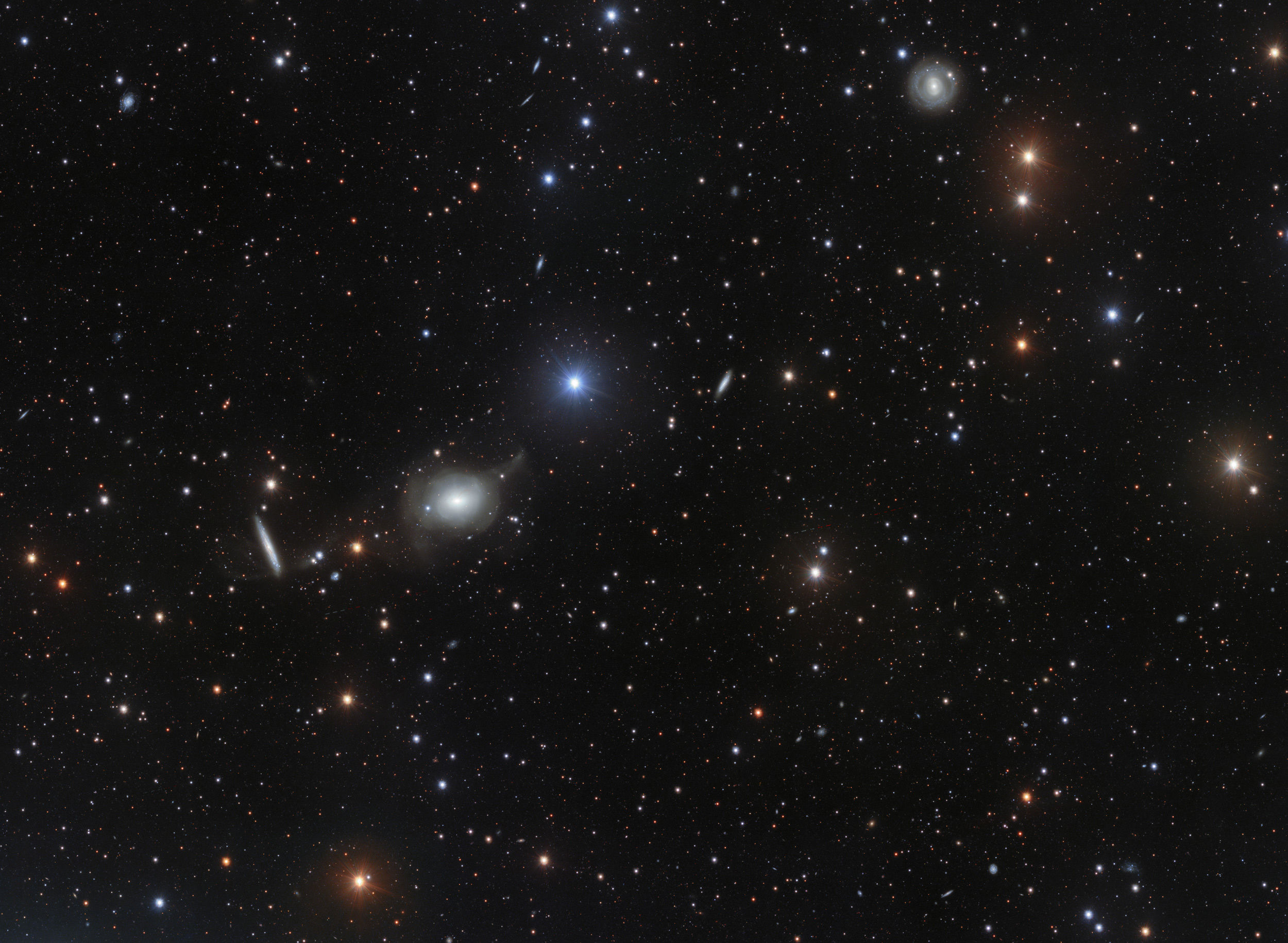Create a free profile to get unlimited access to exclusive videos, sweepstakes, and more!
An elliptical galaxy… kinda

Galaxies — huge collections of gas, dust, dark matter, and stars — come in four very broad types. Spirals, like our Milky Way, have a flat disk with spiral arms. Ellipticals are more puffy, ranging from actual spheres to fairly elongated (American) football shapes. Peculiars have a shape that’s clearly non-random but still weird (like ring galaxies), while irregulars are really just shapeless blobs.
Not every galaxy fits that bill, though. Or, more accurately, you can plop a galaxy into one of those categories, but it doesn’t really indicate the true nature of what’s going on… if we can even figure out what’s going on.
For example, feast your synapses on the wondrous thing that is NGC 5018:
NGC 5018 is the white fuzziness to the left of center. This image is rather wide-angle — it was taken by the Very Large Telescope Survey Telescope (VST), and covers an area of the sky comfortably larger than the full Moon — but the high-res version (which is 136 megapixels, holy yikes!) allows for a bit of a zoom:
Wow! That’s better.
So, how would you classify this object? Astronomers officially have it listed as an E3, a moderately elliptical galaxy (an E0 would be a sphere, and an E9 a very long cigar shape). But looking here I’d say it’s an E3/peculiar. There’s clearly a lot happening in this galaxy, making it far more than a simple elliptical in space minding its own business.
First, you can see it’s surrounded by a lot of shell-like structures centered pretty much on the galaxy’s core. Next, there’s that swooshy thing to the upper right. Then (though it’s tougher to see here, but is far more obvious in other images) there are dark dust lanes cutting across the galaxy’s heart.
All three of these point to an inescapable conclusion: Sometime in the recent past, NGC 5018 ate another galaxy!
At first I wondered if maybe it had suffered a close pass by one, like maybe NGC 5022, the nearly edge-on spiral to the lower left. But the violence done unto NGC 5018 is large, and you’d need a pretty big tussle to create it. The fact that there are no large galaxies nearby makes it far more likely that there used to be two galaxies here, one big and one smaller, and they are in the process of merging.
If the meal galaxy is big enough, an event like that hugely remakes the cannibal galaxy. The shells can be created as streams of stars from the smaller galaxy are flung out, torn off the meal by the gravity of the gourmand. The swoosh to the upper right is likely a “tidal tail,” stars from the larger galaxy pulled off during the early times of the collision. The dust lanes make sense too; elliptical galaxies are nearly devoid of this material, but spirals can have quite a bit, and this stuff would also be peeled off and form loops around the bigger galaxy’s center.
So, done and done, right? Case closed.
Except, yeah, not so much. Studies of NGC 5018 show some weird things.
Collisions like this tend to make lots of stars as gas from one galaxy slams into gas from the other, collapsing the clouds to form stars. There’s not much indication of that here. To be fair, ellipticals tend not to have much gas, so maybe that diminished star formation. But all that stirred-up dust indicates the smaller galaxy must have had plenty of gas (they tend to go together). So the lack of new stars is puzzling.
Also, collisions like this usually take a couple of hundred million years to settle down, so it looks like we’re maybe past the halfway mark here but still a ways from the final product (probably a puffy, slightly bigger elliptical). But the color of the light coming from the stars indicates the vast majority of stars there are about 3 billion years old. That’s weird! This collision couldn’t have been that long ago; it would long since have died down.
One way to explain this is that we’re seeing the aftermath of a more recent, second collision. NGC 5018 collided and merged with a big galaxy 3 or so billion years back, forming lots of stars at the time. Maybe that used up most of its raw material, so when this second collision started with a smaller galaxy, there wasn’t much there to make stars. Still, the pieces don’t quite hang together. There must be more going on.
It’s not clear what. There is gas outside the galaxy that is invisible to our eyes but which emits radio waves, and it can be seen to apparently connect to NGC 5022 to the left. Are they actually connected, or is that a chance superposition of radio emission? It’s hard to say. The two galaxies are at roughly the same distance from us, so they are actually physically close in space. But the connection could still be coincidence.
There are plenty of mysteries to go around in this weird and beautiful object. Poking around the literature I saw plenty of papers about it, many with different pieces of the puzzle, but to me it doesn’t look like we have a complete picture yet. This deep and wide VST image should help, but clearly we have a ways to go before this head-scratcher is understood.
I’m OK with that. I like a Universe that still has things to tell us. Once we know everything, well, then what’s left to discover?




























